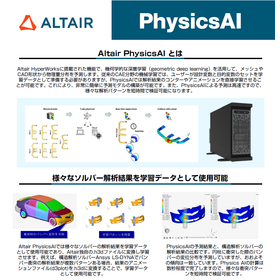Software for coupled analysis of magnetic fields/magnetic fields and heat conduction using the finite element method, performing static analysis and transient response analysis.
This is a software for coupled analysis of magnetic fields/magnetic fields and heat conduction using the finite element method, capable of performing static analysis and transient response analysis. It can handle three-dimensional, two-dimensional, and axisymmetric problems. ■□■Features■□■ ■Since it is an integrated pre- and post-processor dedicated to the PHOTO series, data creation, analysis, and result processing can be performed as a series of operations. ■A revolutionary speedup has been achieved by combining edge element methods and ICCG methods (dozens of times faster than conventional finite element methods). ■The use of the finite element method ensures stable solutions, making it safe for beginners to use. ■Since EDDY (magnetic field analysis module) and THERMO (heat conduction module) are integrated, the transfer of heat generation density is automatically executed without the need for files. ■It is also possible to use EDDY and THERMO separately.
Inquire About This Product
basic information
■ It is possible to perform analyses that take into account the temperature dependence of relative permeability and electrical conductivity at each time step in thermal conduction analysis. (Strong coupling) ■ Since we can consider eddy currents due to induced electromotive force, we can address problems that could not be handled in frequency response analysis. ■ Linear, nonlinear, anisotropic, and hysteresis models of permeability can be considered. ■ Analyses that take into account linear and anisotropic electrical conductivity can be performed. ■ The temperature dependence of permeability and electrical conductivity can be considered. (3D) ■ Nonlinear analysis with temperature-dependent thermal conductivity and specific heat can be performed. ■ Electromagnetic forces acting on magnetic materials and currents are calculated using Maxwell's stress, Lorentz force, and nodal force methods. ■ The slide interface allows for the handling of mutually moving objects. ■ Analyses that consider eddy currents generated in conductors within a varying magnetic field can be performed. ■ The effects of the skin effect on primary side currents can be considered. ■ The external field function allows for easy movement of magnets and coils. ■ Analysis of superconductors can be performed. A highly flexible input for superconducting properties is available (when using user subroutines). ■ The skin layer creation function allows for easy creation of skin meshes.
Price information
-
Delivery Time
Applications/Examples of results
■□■Applicable Fields■□■ Fields that require simulation of phenomena involving eddy currents. Linear motors, magnetic heads, non-destructive testing (eddy current testing), induction heating, free electron lasers, induction machines, RFID-related applications, superconductors, etc.
catalog(1)
Download All CatalogsCompany information
At Photon, we are developing "electromagnetic field analysis software" that models and simulates products and components utilizing electromagnetic phenomena on a computer. In traditional design and development environments, the process has primarily revolved around trial and error through prototyping based on the experience of engineers and experiments with prototypes. However, conducting experiments using actual prototypes and analyzing the results requires significant time and cost. Moving forward, transitioning from an experimental and prototyping-based approach to an analysis-based design approach will be a crucial challenge for improving productivity, and establishing simulation technology as the core of analysis-based design techniques will be essential. In this context, Photon is developing and providing "analysis software" focusing on electromagnetic fields, as well as heat, vibration, and sound fields. By utilizing Photon's software, efficient development and design of various industrial products can be achieved. In this way, Photon aims to support users in reducing the number of prototypes, lowering development costs, and shortening development periods in their manufacturing environments, ultimately enhancing their competitiveness.




![[Fluid-Structure Interaction Case] Drop Analysis of a Water-Filled Bottle Using the ALE Method](https://image.mono.ipros.com/public/product/image/c90/2000811618/IPROS58260664717958022389.png?w=280&h=280)
![[Heat-Fluid-Structure Coupling Example] Cooling of a Metal Pipe](https://image.mono.ipros.com/public/product/image/503/2000811590/IPROS24764595362581102358.png?w=280&h=280)

![[Magnetic Field - Heat - Structural Coupling Case] Analysis of Ultra-High Magnetic Field Generation](https://image.mono.ipros.com/public/product/image/a79/2000811638/IPROS38067428607662637983.png?w=280&h=280)



![SOLIDWORKS 2026 New Features Seminar [Free Participation]](https://image.mono.ipros.com/public/default/object/noimage_l.gif?w=280&h=280)